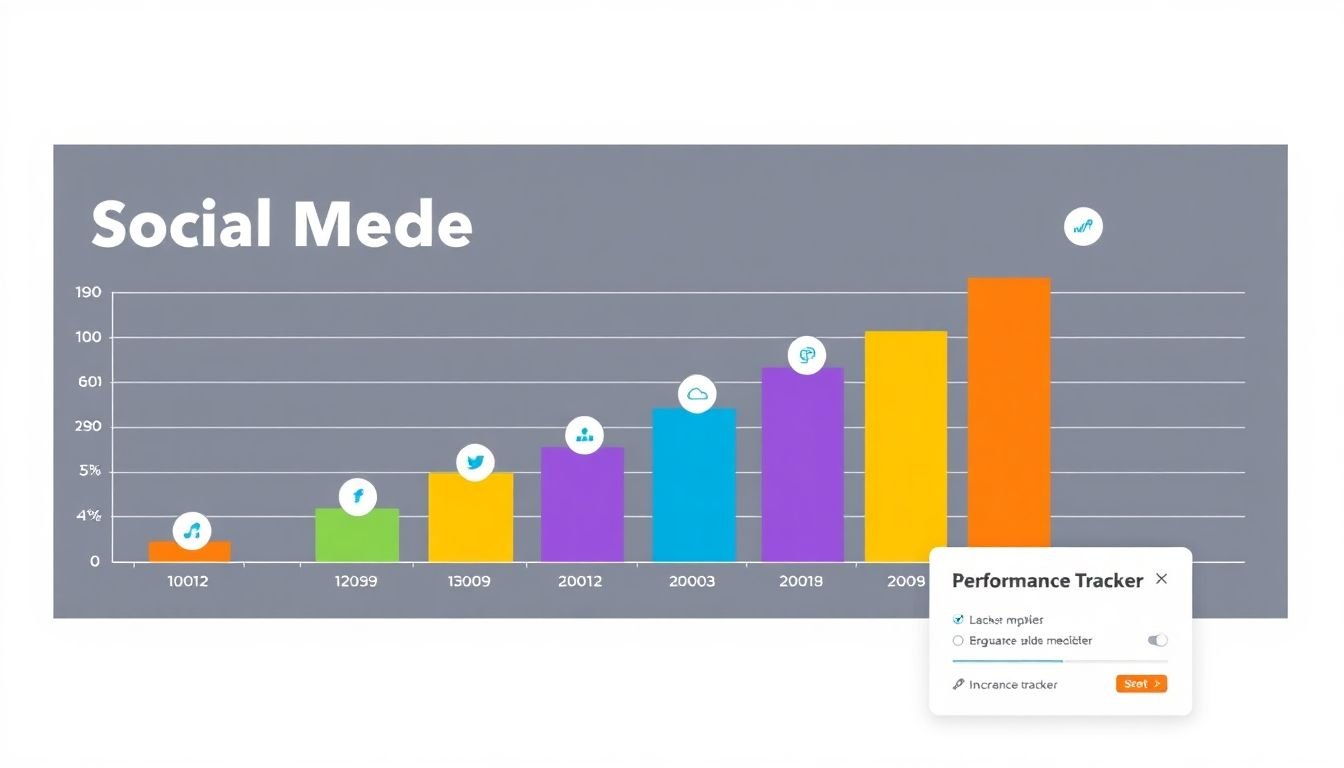
Table of Contents
In the digital age, social media has become an indispensable tool for businesses, large and small. But managing these platforms can be a full-time job, and hiring a dedicated social media manager can seem like a luxury reserved for big corporations with hefty budgets. But what if we told you that you don’t need to break the bank to find the best social media manager for your business? Today, we’re diving into the world of budget-friendly social media management, exploring how to find the perfect fit for your business without overspending. So, grab a cup of coffee, and let’s get started!
First, let’s address the elephant in the room. According to a study by Buffer, small businesses spend an average of 6 hours per week on social media, and that’s on top of their other responsibilities. It’s a time-consuming task, and it’s easy to see why many businesses choose to outsource. But with the average salary for a social media manager in the U.S. hovering around $50,000 per year, it’s also an expensive proposition. So, the question on everyone’s mind is: how can you find a social media manager who won’t break the bank?
We promise, it’s not as daunting a task as it seems. In this article, we’re going to walk you through the process of finding the best budget-friendly social media manager for your business. We’ll explore the benefits of hiring a social media manager, the key qualities to look for, and where to find the best candidates. By the end of this article, you’ll have a clear understanding of how to find the perfect social media manager for your business, without overspending.
But before we dive in, let’s take a moment to agree on a few things. First, we all agree that social media is a powerful tool for businesses. It’s a way to connect with customers, build brand awareness, and drive sales. Second, we agree that managing social media can be a full-time job, and it’s often more effective to have a dedicated social media manager. And finally, we agree that finding the right social media manager doesn’t have to mean breaking the bank. With that out of the way, let’s get started!
Maximize Your Marketing Budget: A Comprehensive Guide to Hiring a Budget-Friendly Social Media Manager
In today’s digital age, social media has undeniably become a powerhouse for businesses, offering unparalleled opportunities to engage with customers, build brand awareness, and drive sales. However, managing these platforms effectively can be a daunting task, especially for small businesses and startups with limited resources. This is where hiring a budget-friendly social media manager comes into play. But how do you ensure you’re getting the most out of your marketing budget? This comprehensive guide is here to help. We’ll delve into the key aspects of hiring a social media manager who understands your brand’s unique voice, knows how to navigate the ever-changing algorithms, and can deliver results without breaking the bank. From understanding the role and required skills to setting a realistic budget and evaluating candidates, we’ll walk you through every step. So, buckle up as we embark on this journey to maximize your marketing budget and unlock the full potential of your social media presence.

Understanding the Role of a Social Media Manager
In the dynamic digital age, the role of a Social Media Manager has evolved into a pivotal position, acting as the bridge between businesses and their online communities. Their primary responsibility is to develop, implement, and manage a company’s social media strategy, ensuring it aligns with overall business objectives.
The role is multifaceted, requiring a diverse skill set. Firstly, they must possess exceptional communication skills, as they are the voice of the brand across various platforms. They craft engaging content, from captions to long-form posts, that resonates with the target audience. Secondly, they are analytical, using tools like Google Analytics and platform-specific insights to track performance metrics. This data-driven approach helps them refine strategies and maximize ROI.
Social Media Managers also wear the hat of community managers. They engage with followers, respond to comments and messages, and foster a sense of community around the brand. They are the eyes and ears of the business, monitoring social media for mentions, feedback, and trends that could influence the brand.
The importance of this role in today’s business landscape cannot be overstated. Social media is no longer just a marketing tool; it’s a crucial channel for customer service, reputation management, and even sales. A skilled Social Media Manager can help businesses grow by increasing brand awareness, driving traffic to websites, and generating leads. They can also humanize brands, creating emotional connections with customers that translate into loyalty.
Moreover, they play a vital role in crisis management. In the event of a social media crisis, they are the first line of defense, mitigating damage and ensuring the brand’s reputation remains intact.
In essence, the Social Media Manager is a jack of all trades, master of many. Their role is complex, demanding, and ever-evolving, but it’s also rewarding. They are the architects of a brand’s online presence, shaping its image, voice, and relationships in the digital world.

The Importance of Budget-Friendliness in Hiring
When it comes to hiring a social media manager, one aspect that often gets overlooked is the importance of budget-friendliness. In today’s digital age, social media presence is more crucial than ever for businesses, but it’s also an area where costs can quickly spiral out of control. This is why it’s crucial to consider budget when hiring a social media manager.
Firstly, a budget-friendly manager allows businesses to allocate resources more effectively. By hiring someone who fits within your financial means, you can ensure that you’re not overspending on one area, which could potentially lead to neglecting other important aspects of your business. This balance is key to sustainable growth.
Secondly, a budget-friendly manager can bring a fresh perspective and innovative ideas to the table. They often come with a hunger to prove themselves and a willingness to go the extra mile. This can lead to creative strategies that might not have been considered by more expensive, established professionals.
Moreover, a budget-friendly manager can help businesses grow without breaking the bank. They understand the importance of maximizing returns on investment and are more likely to focus on strategies that provide high ROI. This could include leveraging free tools, optimizing content for maximum engagement, and utilizing user-generated content.
Lastly, hiring a budget-friendly manager allows for room to grow and expand. As your business grows, you can reinvest the savings into other areas, such as marketing automation tools or additional team members. This creates a positive feedback loop where cost-efficiency drives growth, which in turn allows for further investment.
In conclusion, while it might be tempting to go for the most expensive, high-profile candidate, it’s often the budget-friendly manager who can provide the most value. They offer a balance between cost and quality, allowing businesses to grow and thrive without overspending.

Defining Your Business Needs and Budget
Defining your business’s social media needs and budget is a critical step in ensuring your online presence aligns with your business goals. Let’s embark on this journey together, step by step.
First, assess your business’s social media needs. Consider your target audience and where they’re most active. Are they on visual platforms like Instagram or Pinterest, or do they prefer professional networks like LinkedIn? Next, evaluate your content. Do you have a steady stream of engaging content, or do you struggle to keep up? Lastly, think about your goals. Are you looking to increase brand awareness, drive traffic to your website, or boost sales?
Once you’ve assessed your needs, it’s time to set a realistic budget. Social media management services can vary widely in cost, from a few hundred dollars to several thousand per month. Consider your business size and goals when setting your budget. Remember, you get what you pay for, but that doesn’t mean you have to break the bank.
Now, let’s talk about what you can expect from a budget-friendly social media manager. They should be able to:
- Create and maintain a consistent brand voice and aesthetic across platforms.
- Develop and implement a content strategy that aligns with your business goals.
- Engage with your audience and respond to comments in a timely manner.
- Provide regular reports on your social media performance.
- Offer strategic guidance and stay up-to-date with the latest social media trends and best practices.
They may not be able to handle complex ad campaigns or provide in-depth data analysis, but they should be able to provide excellent value for your money. Happy budgeting!

Where to Find Budget-Friendly Social Media Managers
In today’s digital age, maintaining a strong social media presence is crucial for businesses of all sizes. However, hiring a full-time social media manager can be a significant investment. If you’re on a budget, fear not! There are numerous platforms and methods to find budget-friendly social media managers. Let’s dive in.
The first stop on our journey is the vast world of freelance websites. Platforms like Upwork, Fiverr, and Freelancer.com host a global marketplace of freelance social media managers, ready to take on projects at varying rates. To find the best fit, be sure to check portfolios, read reviews, and communicate your project details clearly.
Next, let’s explore the power of social media groups. Joining industry-specific groups on platforms like Facebook and LinkedIn can connect you with affordable social media managers. These groups often have members who are eager to take on new projects to build their portfolio or gain experience. Be sure to clearly state your budget and project details in your post.
Lastly, don’t overlook the potential of your local network. Reach out to local business groups, chambers of commerce, or even your university alumni network. You might find a recent graduate or a local professional looking to expand their services. Here’s a simple way to structure your request:
- Introduce yourself and your business
- Clearly state your budget and project details
- Ask for recommendations or if anyone is interested in the opportunity
Happy hunting!

Evaluating Candidates: Skills and Experience
Evaluating candidates’ skills and experience is a critical step in the hiring process. It’s not just about checking off boxes, but about understanding how their abilities and past experiences align with the role and your company’s culture. Here’s a detailed guide to help you navigate this process.
Reviewing Resumes and Portfolios:
Start by carefully reviewing candidates’ resumes and portfolios. Look for relevant skills and experiences, but also pay attention to the way they present themselves. A well-structured resume or portfolio can indicate attention to detail and professionalism. Red flags to watch out for include inconsistencies in information, gaps in employment history that can’t be explained, or a lack of relevant skills.
Skills Evaluation:
- Once you’ve identified key skills required for the role, create a scoring system to evaluate candidates. This could be based on a scale of 1-5, with 5 being expert level. Here’s how you can score:
Technical Skills:
- Assess these based on their resume, portfolio, and interview responses. Ask candidates to describe complex projects they’ve worked on and how they overcame challenges.
Soft Skills:
These are harder to quantify but crucial. Look for evidence of communication, teamwork, problem-solving, and adaptability in their resume and portfolio. During interviews, ask behavioral questions to understand how they’ve demonstrated these skills in the past.
Experience Evaluation:
Consider the breadth and depth of their experience. Has the candidate worked on similar projects or in similar roles? Have they taken on leadership or mentoring roles? Red flags include a lack of progression in their career, frequent job-hopping, or a history of poor performance.
Interview Questions:
- Here are some questions to ask during interviews to evaluate skills and experience:
Behavioral Questions:
- ‘Tell me about a time when…’ These help you understand how candidates have handled situations in the past and how they might handle them in the future.
Scenario-Based Questions:
- Present candidates with hypothetical situations and ask how they would respond. This can help you understand their problem-solving skills and how they think on their feet.
Technical Questions:
- These should be role-specific and designed to test the candidate’s knowledge and skills. Make sure they’re not too easy or too hard
- you want to see how the candidate performs under pressure, but you also want to give them a chance to show what they know.
Portfolio Review:
If the role requires creative or technical skills, ask candidates to submit a portfolio. Review this carefully, looking for evidence of the skills and experiences they’ve highlighted in their resume and interview. Red flags include work that’s clearly not their own, or work that’s not up to the standard you’d expect for the role.
Final Thoughts:
Remember, the goal of evaluating candidates’ skills and experience is to find the best fit for your team. It’s not just about checking off boxes, but about understanding how a candidate’s unique combination of skills and experiences can contribute to your company’s success.

The Art of Negotiation: Discussing Rates and Services
Embarking on the journey of hiring a social media manager can be an exciting yet daunting task. One of the most crucial aspects of this process is negotiating rates and services, a skill that, much like any art, requires finesse, understanding, and a dash of creativity. Let’s dive into the world of negotiation, armed with tips to help you navigate this process with confidence.
The first brushstroke in this art piece is clear communication. It’s the foundation upon which the entire negotiation stands. Begin by being transparent about your expectations, budget, and the scope of work. This isn’t a time for ambiguity; be specific about what you’re looking for. Remember, a social media manager is an investment in your brand’s future, and like any investment, it’s important to know what you’re getting in return.
Now, let’s talk about setting expectations. This is where you roll out your vision for your social media presence. What are your goals? Are you looking to increase engagement, drive traffic to your website, or boost sales? Make sure your potential manager understands the endgame. This will not only help them tailor their services to your needs but also gives them a benchmark to measure their success.
Once you’ve laid out the canvas, it’s time to discuss rates. This is where many people feel a sense of trepidation, but remember, negotiation is a two-way street. Here are a few steps to guide you:
- Research industry standards. Knowing what the market rate is for social media management services will give you a solid starting point.
- Consider the value they bring to the table. If a manager has a proven track record of success, they might charge more, but the return on investment could be significant.
- Be open to discussing packages. Some managers may offer bundled services at a discounted rate.
- Don’t be afraid to ask about their process. Understanding how they work can help you see the value in their services.
Lastly, always remember that negotiation isn’t about winning or losing. It’s about finding a mutually beneficial agreement. A good social media manager will understand your constraints and work with you to find a solution that works for both parties.
So, go forth, negotiate with confidence, and remember, the art of negotiation is about creating a masterpiece, not a masterclass in haggling.

Onboarding and Working with Your New Social Media Manager
Welcome to the exciting journey of onboarding a new social media manager! This process is not just about handing over the reins, but also about setting them up for success. Let’s dive into a step-by-step guide to ensure a smooth transition and a productive working relationship.
Step 1: Define Clear Goals and Expectations
Before your new manager dives into the deep end, it’s crucial to set clear, measurable goals. These could include increasing engagement, growing followers, or improving click-through rates. Use the SMART framework (Specific, Measurable, Achievable, Relevant, Time-bound) to ensure your goals are well-defined. Communicate these expectations clearly and regularly.
Step 2: Provide Access and Familiarize with Platforms
Your new manager will need access to all your social media platforms. Here’s how you can facilitate this:
- Provide login credentials for each platform, ensuring they have the appropriate access levels.
- Walk them through your brand’s presence on each platform, highlighting what’s working and what’s not.
- Introduce them to any third-party tools or analytics platforms you use.
Encourage them to explore and familiarize themselves with these platforms to understand your brand’s current social media landscape.
Step 3: Establish Communication Norms
Effective communication is key to a successful working relationship. Establish norms early on:
- Set up regular check-ins to discuss progress, challenges, and ideas. This could be daily, weekly, or bi-weekly, depending on your needs.
- Agree on response times for messages and emails. While you don’t want to micromanage, it’s important to ensure they’re responsive to your needs.
- Discuss how you prefer to receive updates
- whether it’s through regular reports, quick messages, or a project management tool.
Remember, communication is a two-way street. Encourage your new manager to ask questions and share ideas.
Step 4: Provide Context and Resources
Your new manager will need to understand your brand’s voice, tone, and style. Provide them with:- A comprehensive brand style guide.
- Access to any relevant internal documents, such as marketing plans or customer personas.
- An introduction to key team members and stakeholders.
Also, share any relevant industry reports, trends, or insights to help them stay informed.
Step 5: Trust and Empower
Finally, trust your new manager’s expertise. Empower them to make decisions and try new strategies. After all, you’ve hired them for their skills and insights. Regularly review their progress, provide constructive feedback, and celebrate their successes. This will not only help them grow but also strengthen your brand’s social media presence.

Monitoring Progress and Performance
Tracking the performance of your social media manager and their strategies is a crucial step in ensuring your online presence aligns with your business goals. The process involves setting clear objectives, defining key performance indicators (KPIs), and utilizing appropriate tools to monitor progress. Let’s dive into these aspects to create a comprehensive approach to social media performance tracking.
Firstly, it’s essential to establish specific, measurable, achievable, relevant, and time-bound (SMART) objectives. These could range from increasing brand awareness, driving website traffic, to generating leads or sales. Once your goals are set, you can identify the KPIs that will help you measure progress.
Some key KPIs to consider include:
- Reach and Impressions: Measure the number of unique users who saw your content and the total number of times your content was displayed.
- Engagement Rate: Calculate the percentage of users who interacted with your content (likes, comments, shares) out of the total number of impressions.
- Click-Through Rate (CTR): Track the percentage of users who clicked on a link in your post out of the total number of users who saw it.
- Conversion Rate: Measure the percentage of users who completed a desired action (like purchasing a product or signing up for a newsletter) after clicking through from social media.
- Follower Growth: Monitor the increase or decrease in your social media following over time.
These KPIs can vary depending on your specific goals and the platforms you’re using.
To track these KPIs, there are numerous tools available. Google Analytics is a powerful, free tool that can provide insights into website traffic generated from social media and help measure conversions. Social media platforms themselves also offer analytics tools, such as Facebook Insights, Instagram Insights, and Twitter Analytics. Additionally, third-party tools like Hootsuite Insights, Sprout Social, and Buffer can provide an overview of your social media performance across multiple platforms.
Regularly reviewing these KPIs and tools will help you understand what’s working and what’s not in your social media strategy. This data-driven approach allows you to make informed decisions, adjust your strategies as needed, and ultimately improve your social media performance.

When to Upgrade: Moving from Budget-Friendly to Premium
When your business has outgrown its startup phase and you’re ready to take your social media presence to the next level, it might be time to consider upgrading from a budget-friendly social media manager or agency to a premium one. But how do you know when the right time is? Let’s explore some signs that indicate it’s time for an upgrade.
Firstly, if you find that your current manager or agency is consistently struggling to keep up with your growing needs, it might be a sign that they’re stretched too thin. This could manifest as delayed responses, missed opportunities, or a lack of innovative ideas. Secondly, if you’re noticing a decline in engagement or growth on your social media platforms, despite your team’s best efforts, it could be time to bring in fresh perspectives and advanced strategies.
Another sign is when you’re ready to expand your social media reach and explore new platforms, but your current team lacks the expertise or resources to do so. Premium agencies often have specialists in various platforms and trends, ensuring you’re always ahead of the curve. Additionally, if you’re looking to integrate social media more deeply into your overall marketing strategy, a premium agency can provide the strategic guidance and data-driven insights you need.
Making the transition to a premium agency doesn’t have to be a daunting task. Here are some steps to ensure a smooth upgrade:
-
Assess Your Needs:
- Clearly define what you’re looking for in a new agency. This could include specific services, industry expertise, or a certain size of team.
Research and Shortlist:
- Based on your needs, create a list of potential agencies. Look at their portfolios, client testimonials, and industry recognition.
Meet and Discuss:
- Reach out to your shortlisted agencies for a meeting or call. Discuss your goals, challenges, and expectations. This is also a good time to ask about their onboarding process.
Transition Plan:
Once you’ve chosen an agency, work with them to create a transition plan. This should include a handover period, data migration, and a plan for maintaining consistency in your social media voice and branding.
Remember, upgrading to a premium social media manager or agency is an investment in your business’s growth. With the right team in place, you’ll be well-equipped to navigate the ever-evolving world of social media and take your brand to new heights.
FAQ
What is a Social Media Manager and why is it crucial for my business?
How can I find a budget-friendly Social Media Manager for my business?
- Leverage professional networks like LinkedIn, Facebook groups, and online forums for recommendations.
- Check freelance platforms such as Upwork, Fiverr, and Freelancer, where you can find affordable professionals.
- Look for recent graduates or students who may offer their services at lower rates while gaining experience.
- Consider hiring a part-time or virtual assistant who can handle social media tasks alongside other duties.
What should I look for in a budget-friendly Social Media Manager?
- Relevant experience and a strong portfolio showcasing their skills.
- Understanding of your industry and target audience.
- Proven ability to create engaging content and grow social media presence.
- Proficiency in social media management tools and analytics platforms.
- Excellent communication skills and cultural fit with your business.
Remember, while budget is important, it’s equally crucial to find someone who can deliver results.
How much should I expect to pay a budget-friendly Social Media Manager?
Can I manage social media myself and save money?
What kind of services should I expect from a budget-friendly Social Media Manager?
- Content creation and curation tailored to your brand voice and target audience.
- Post scheduling and management across multiple platforms.
- Engagement with your audience through comments, messages, and reviews.
- Basic analytics and reporting to track performance and provide insights.
- Strategic planning and advice to help grow your social media presence.
However, the scope of services may vary depending on the SMM’s experience and your agreed-upon budget.
How can I ensure my budget-friendly Social Media Manager is a good fit for my business?
- Conduct interviews and ask for references to assess their communication skills and cultural fit.
- Provide them with a detailed job description and ask for a tailored proposal or plan outlining their approach to your business’s social media needs.
- Check their understanding of your industry, target audience, and business goals.
- Discuss their preferred tools and platforms, and ensure they align with your business’s needs.
- Set clear expectations, KPIs, and a trial period to evaluate their performance.